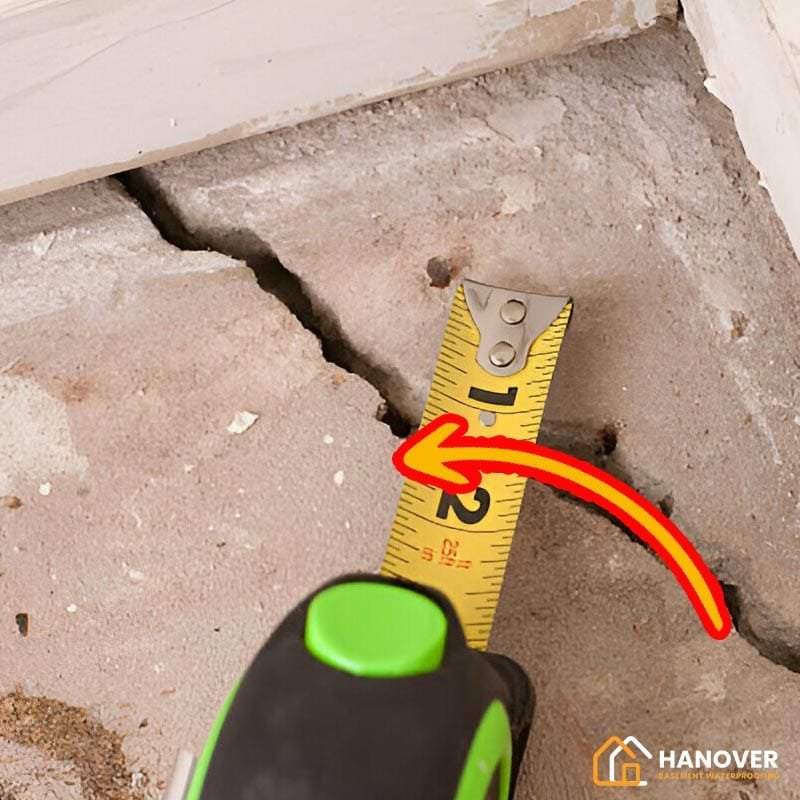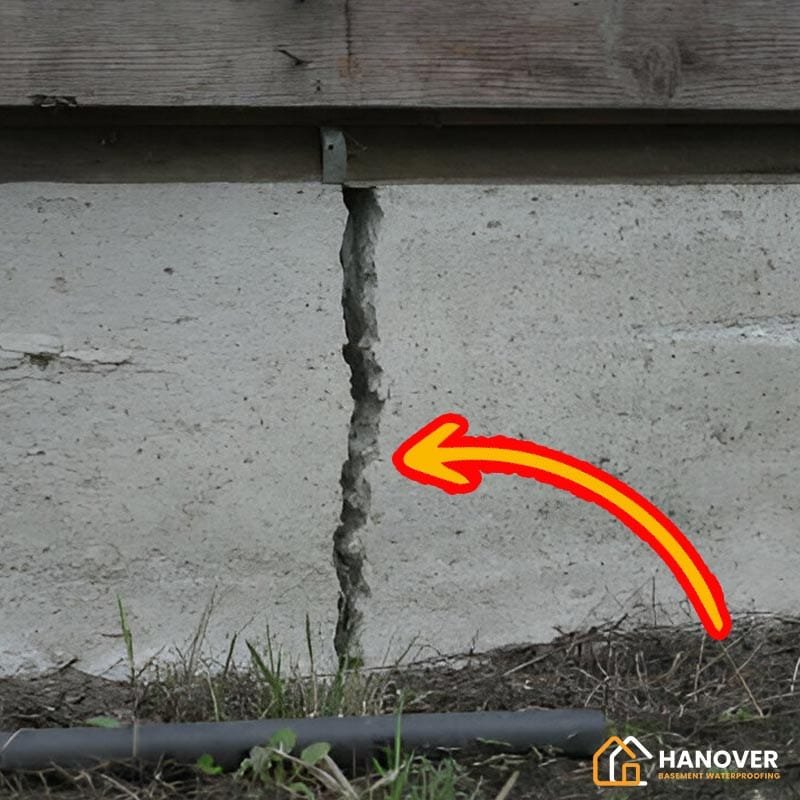Foundation cracks are more than cosmetic flaws—they’re early warnings of structural damage that could cost thousands in repairs. In areas like Hanover, PA, where seasonal changes, soil movement, and high rainfall variability create unique risks, it’s essential to take preventive action before damage begins. This guide breaks down the six most critical steps for preventing foundation cracks—backed by proven strategies and region-specific context.
Why Foundation Cracks Form
The causes behind foundation cracks are complex but generally fall into three categories: soil-related movement, water intrusion, and construction flaws. In Hanover, clay-heavy soil and the region’s freeze-thaw cycle amplify the stress on concrete foundations. When moisture seeps into the soil and freezes, it expands, putting pressure on the foundation walls. In warmer months, the soil contracts, leaving voids that can lead to settling and eventual cracking. Unchecked, these shifts can compromise the structural integrity of the entire building.
Importance of Preventative Maintenance
Preventing damage is far more cost-effective than repairing it. Routine inspections, drainage control, and landscape planning can drastically reduce the risk of developing cracks. If you’re a homeowner in south-central Pennsylvania, this isn’t just optional—it’s essential. Preventative maintenance also plays a major role in preserving property value and avoiding failed home inspections during resale.
Step 1: Inspect Foundation Regularly
Regular inspections are the foundation of prevention. A proactive inspection routine helps you catch hairline fractures, minor displacements, or signs of hydrostatic pressure before they evolve into severe structural issues.
What to Look For
Begin with a visual inspection of the foundation walls, both inside and outside the structure. Look for:
- Vertical or horizontal cracks
- Cracked or crumbling concrete
- Signs of moisture seepage
- Stains from rust or mold
- Gaps between walls and framing
Use a flashlight and level to detect subtle shifts. In finished basements, pay attention to drywall cracks, floor sagging, and musty odors, all of which may indicate underlying moisture issues.
Inspection Frequency
In regions with shifting weather like Hanover, PA, it’s best to inspect:
- Twice annually—ideally in early spring and late fall
- After heavy rains, floods, or snow melts
- Before purchasing or selling a property
Homeowners can perform basic checks, but a professional structural engineer or foundation specialist should conduct detailed assessments at least every few years. Resources like the American Society of Home Inspectors can help you locate certified professionals in your area.
Tools That Help
While visual checks are helpful, advanced tools can improve accuracy:
- Moisture meters to detect hidden leaks
- Crack monitors to measure changes over time
- Laser levels for floor slope detection
Step 2: Maintain Proper Drainage
Water accumulation around the foundation is one of the leading causes of foundation cracking. In Hanover, PA, where rainfall is uneven and often intense, maintaining effective drainage is vital to avoid soil expansion, hydrostatic pressure, and erosion that weaken the foundation over time.
For homes with limited grading options, crawl space drainage systems offer reliable protection against rising groundwater and long-term moisture exposure.
Why Drainage Matters
When rainwater is not directed away from the structure, it can pool around the base and saturate the soil surrounding the foundation. This causes the soil to expand and press against foundation walls. Over time, as water evaporates or drains unevenly, the soil contracts, leaving behind air pockets and compromising support. These cycles cause differential settlement, a major contributor to horizontal or step cracks.
Drainage Solutions for Long-Term Stability
Implementing a few key drainage solutions can dramatically reduce risk:
- Clean and extend downspouts so that water is directed at least 5–10 feet from the foundation.
- Install or repair gutters to ensure proper runoff.
- Grade the landscape so that soil slopes away from the house at a minimum of 6 inches over 10 feet.
- Create swales or French drains to divert surface water effectively.
- Seal any gaps between walkways, driveways, and the foundation using weather-resistant caulk.
For homeowners in Hanover, consider integrating rain barrels to manage roof runoff and ease pressure on soil during storm events. This sustainable option also conserves water during dry seasons.
Early Warning Signs of Poor Drainage
Common red flags that suggest your drainage is inadequate include:
- Pooled water near the base of the home after rain
- Soil erosion or exposed foundation walls
- Basement dampness or white chalky stains known as efflorescence
- Gutter overflows or broken splash blocks
Addressing these signs early can prevent costly damage down the line.
Step 3: Control Landscaping
The area around your home’s foundation should be carefully planned and maintained to prevent unwanted soil movement, water pooling, and root pressure. Trees, shrubs, and even garden beds can play a major role in either safeguarding or compromising the stability of your foundation.
Plant Selection and Placement
Certain plants have aggressive root systems that can extend into and beneath foundations. These roots seek out moisture and can contribute to soil displacement, especially in Hanover’s clay-based terrain, where soil shifts more dramatically with moisture variation.
When landscaping:
- Avoid planting large trees within 20–30 feet of the foundation.
- Use shrubs with shallow root systems near the house.
- Choose native or low-water plants to reduce soil desiccation during dry periods.
- Mulch lightly near the foundation to retain moisture without adding weight or attracting pests.
Popular plants to avoid near foundations include:
- Willow
- Maple
- Elm
- Poplar
Instead, opt for foundation-friendly species like boxwood, dwarf yew, or ornamental grasses.
Landscape Grading and Materials
It’s not just what you plant—but where and how. Ensure that:
- Mulch and soil are not piled above the foundation line
- Hardscaping features like patios or walkways are designed with a slight grade away from the home
- Irrigation systems are directed outward, never toward the foundation
Homeowners in Hanover often overlook the effects of frost heave, where expanding frozen soil can lift landscaping features and redirect water toward the house. Prevent this with proper edging, flexible materials, and routine winter checks.

Step 4: Apply Waterproofing Measures
Waterproofing your foundation is one of the most effective defenses against both minor moisture seepage and long-term structural damage. In a region like Hanover, PA, with fluctuating moisture conditions and heavy seasonal rainfall, proactive sealing and barrier installation can prevent cracks before they start.
Interior vs. Exterior Waterproofing
Understanding the distinction between internal and external methods helps determine the best approach:
- Interior waterproofing includes applying sealants and vapor barriers to walls and floors to prevent moisture intrusion. It also may involve installing sump pumps and interior drainage systems to redirect water away from the basement.
- Exterior waterproofing involves excavating around the foundation, applying liquid membranes or drainage panels, and installing perimeter drains that stop water before it reaches the interior.
For Hanover homes with older construction or inadequate grading, exterior solutions offer more comprehensive protection but may require greater investment and professional labor. Hanover basements often rely on sump pump installation to manage heavy runoff and protect against groundwater infiltration year-round.
Materials That Matter
Choose long-lasting, code-compliant materials:
- Elastomeric membranes offer flexibility for foundation walls subject to movement.
- Bituminous coatings provide dense, waterproof layers suitable for severe water exposure.
- Drain tiles and gravel barriers support natural runoff control.
When applying DIY sealants, ensure surfaces are clean, dry, and structurally sound. For high-risk properties, hire certified contractors with local experience to avoid installation errors.
Step 5: Monitor Humidity and Temperature
Moisture control is not just an outdoor issue. High interior humidity and temperature fluctuations contribute to condensation, mold growth, and eventually foundation damage through continuous material stress.
Basement Conditions and Moisture
In Hanover, basements are common, and they often lack adequate airflow. Homeowners should aim to keep indoor humidity between 30–50%. Signs of excessive moisture include:
- Condensation on pipes or walls
- Musty odors
- Mold or mildew patches
- Warped wood or buckling floors
Using dehumidifiers, ventilation fans, and hygrometers can help regulate moisture. Seal all wall penetrations (pipes, wires) and consider installing vapor barriers behind insulation.
External Influences
The freeze-thaw cycle unique to Hanover puts extra stress on foundations. As external temperatures swing below and above freezing, water inside small foundation cracks expands and contracts, worsening existing damage.
Routine checks during seasonal transitions, especially late winter into early spring, help detect changes that could indicate freeze-related stress. Use thermal imaging or infrared sensors for deeper analysis.
Step 6: Schedule Professional Inspections
Even with the best DIY practices, nothing replaces the trained eye of a foundation expert. Routine inspections by licensed professionals ensure hidden problems are caught early and that your prevention strategies are working.
When to Hire a Specialist
Consider hiring a professional if:
- You observe new or expanding cracks
- Moisture returns after repairs
- You are preparing to buy or sell a home
- You live in a high-risk zone with poor soil drainage
Services to request include:
- Structural assessments by licensed engineers
- Moisture testing and water intrusion diagnostics
- Load distribution evaluations to check for settlement
In Hanover, seek inspectors familiar with local soil conditions and building codes. Verify licensing through state directories and refer to organizations like the International Association of Certified Home Inspectors for listings.
Final Thoughts
Protecting your foundation is not just a one-time project—it’s a continuous strategy that evolves with the structure, the soil, and the environment. By following these six proven steps, homeowners in Hanover, PA, and beyond can prevent cracks before they start, saving time, money, and the structural integrity of their homes for years to come.
FAQs
How does poor drainage cause foundation cracks?
Poor drainage allows Water to pool around your foundation, softening the Soil and causing it to shift. This movement creates pressure on foundation walls, leading to cracks. Over time, trapped moisture can also weaken concrete and contribute to basement leaks. Proper grading, gutters, and drainage systems help prevent these issues.
Can landscaping affect foundation stability?
Yes. Trees and large plants near your home can absorb moisture from the Soil, causing it to shrink and create gaps under your foundation. Improper grading or flower beds too close to the home can also trap Water against the foundation, increasing the risk of cracks. Good landscaping methods, like root barriers and gravel drainage, keep the foundation stable.
Why is controlling moisture important?
Moisture fluctuations cause Soil to expand when wet and contract when dry, leading to foundation movement and cracks. Balancing soil moisture is key. Use proper drainage, avoid overwatering, and add mulch or gravel. This helps stop shifting and keeps your foundation safe from stress.
How often should I inspect my foundation?
A full foundation inspection should be done at least twice a year, ideally in spring and fall, when weather changes can impact soil movement. Also, check your foundation after heavy rain, drought, or big temperature changes. This way, you can find early signs of damage before they get worse.
Are all foundation cracks a cause for concern?
No, not all cracks indicate serious issues. Small hairline or shrinkage cracks are common and usually cosmetic. Wide cracks (over 1/4 inch), horizontal cracks, stair-step cracks in brick, or cracks that grow over time might mean structural issues. So, it’s best to have a professional inspect them.

